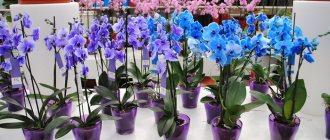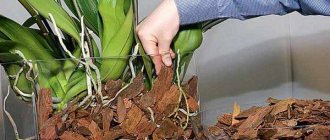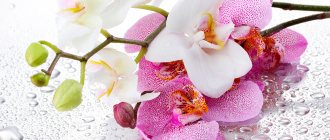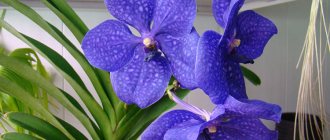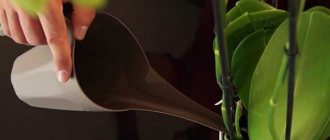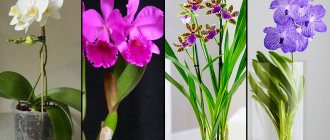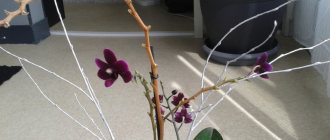Among the huge variety of orchid species grown indoors , Miltonia is considered one of the most popular tropical beauties.
Its rich greenery, lush and long-lasting flowering, and most importantly, the exotic, exquisite shape of the flowers force lovers all over the world to endure the rather capricious nature of the orchid , creating comfortable conditions for its growth.
Miltonia in natural growing conditions
The Miltonia orchid, which appeared in greenhouses and private collections in the 19th century, was brought to Europe from the countries of the South American region .
The natural habitat for this magnificent beauty is the tropical forest zone in Brazil and Argentina, as well as in the mountainous regions of Paraguay. Interesting! Most of the species of Miltonia like to settle in elevated areas (up to 900 meters), and some species occupy an even higher natural niche - up to 1.5 km.
Epiphytic orchids are attached to tree trunks, using them only as a support and a way to take a comfortable living position. Orchids hovering above the earth .
Miltonia is a herbaceous perennial. All its species belong to the sympodial type of development, that is, they grow horizontally due to the growth of the rhizome (rhizome) and the pseudobulbs (shoots) formed on it.
The leaves of the plants are narrow - long, lush green. Small (up to 12 cm), flowers of various colors with a delicate aroma are collected in racemes.
Curious! Miltonia received its generic name thanks to the Englishman E. Milton, a passionate collector of orchids. But it also has another popular name - the “Pansy” orchid, which speaks of the similarity of the flowers of these two plants.
Aphrodite
Phalaenopsis Aphrodite is a natural species that is found in Indonesia, the Philippines, northern Australia, Papua New Guinea, and Taiwan. The plant received its name in honor of the Greek goddess of love.
Aphrodite.
Story
This type of orchid was first discovered and described by a Jesuit monk back in the 17th century, but naturalists did not pay attention to these notes. Carl Linnaeus also ignored the plant when compiling the first list of orchids.
Only in 1837 did one specimen reach Europe , but it was classified as another species known at that time, Phalaenopsis amabilis. It was only in 1862 that this orchid was registered as a new species.
External characteristics and distinctive features
The plant is characterized by elongated oval light green leaves up to 25 cm long. Sometimes there may be lighter stripes on the leaves. Peduncle drooping up to 40 cm long, sometimes branched with white graceful flowers. There are few color options. In most cases, the flowers are pure white, rarely with a slight purple tint.
In most cases, the flowers are pure white, rarely with a slight purple tint.
Interesting! Numerous clones of Phalaenopsis Aphrodite, which are currently bred by orchid producers, most often have chromosomal abnormalities, which makes it difficult to propagate them from seeds and cross them with other species.
Primary hybrids
More than 10 primary hybrids are known , i.e. descendants from crossing Phalaenopsis Aphrodite with other species. Some of them arose naturally and were found in nature, such as Phalaenopsis ×intermedia. Others were obtained artificially. However, primary hybrids are of great importance for the development of new varieties.
Features of flowering and color options
Phalaenopsis Aphrodite, under appropriate conditions, can bloom at any time of the year, but most often flower arrows appear on the windowsill in the spring .
It is worth noting that it is impossible to find a natural look on store shelves . Plants with white flowers are found in abundance, but they are most likely the product of hybridization.
White flowers are the main petal color, although a slight purple tint may be present even in species specimens. Yellow and carmine-red spots and streaks are often visible at the base of the lip. The diameter of the flowers can reach 8 cm.
blue phalaenopsis Aphrodite on sale , but buying such a plant will only bring disappointment:
- Firstly, such an orchid has nothing in common with its natural appearance,
- Secondly, when they bloom again, the color of the flowers will be white.
Look what the blue phalaenopsis Aphrodite looks like in the photo!!!
Blue Aphrodite.
And here you can look at Aphrodite, bought on eBay:
Orchids with blue flowers are most often obtained by watering the plant with a dye, which is washed out by the next flowering.
An exception can be considered a transgenic hybrid bred in Japan in 2013 . Its color is indeed blue, but it is unlikely that it will appear on sale in the near future.
Popular species of Miltonia
The generic taxon Miltonia includes, according to various sources, up to 20 natural species and many newly bred varieties. The most popular ones are shown in the photo.
Snow white Miltonia (M. candida)
A distinctive feature of the orchid is the brown-yellow star of its corolla with a prominent white lip. Closer to the core, the lip is colored lilac .
Flowering occurs closer to autumn. A fragrant cluster of 3-5 flowers is formed on each peduncle.
Miltonia clowesii (M. clowesii)
Orchid inflorescences bear about 10 graceful corollas of reddish-brown color. The petals have a wavy outline. Three of them are directed upward, and two go down and border the original shape of the lip of a whitish tone with a purple middle.
Blooms from April to December.
Miltonia Warshevich (M. wascewiezii)
The orchid has large branched arrows with intricately shaped flowers. The pinkish-brown petals are distinguished by a backward-curving, wavy outline .
A milky lip with a brownish spot in the center makes up most of the flower.
If you constantly remove faded corollas from the inflorescence, you can achieve non-stop flowering due to the formation of peduncles on the sides of the main one.
Miltonia brilliant (M. spectabilis)
The orchid is distinguished by a single arrangement of corollas on the peduncle (two are less common).
The flowers are quite large, white-beige in color, but they can also be lilac-lilac in color . The corollas look like pansies.
Blooms from late summer to mid-autumn .
The orchid is not picky about temperature changes.
Miltonia yellowish (M. flavesctns)
Orchid leaves can change color depending on the lighting.
A distinctive feature is a meter-long peduncle with a large number (up to 15 pieces) of buds . Delicate yellow flowers with narrow petals and a wavy lip. Has a pleasant aroma.
Flowering - from mid-winter to October.
Miltonia regnellii (M. regnellii)
Orchid leaves have a glossy surface.
Up to 6 buds are formed on a dense, . The petals of the flowers are white; on the larger lip there is a bright lilac-lilac spot.
Orchid with a pronounced fragrant aroma.
Miltonia cuneata (M. cuneata)
Orchids bloom in February-March.
The petals of the orchid are light yellow in color and densely covered with brownish-reddish streaks. The whitish lip has a slight lilac coating. The whisks exude the most delicate aroma.
Miltassia orchid Miltassia
The orchid was obtained as a hybrid from crossing Miltonia and Brassia. It is distinguished by large , star-shaped corollas with a prominent rounded lip . The colors of the corollas are varied in color and pattern.
Flowering occurs in autumn.
Miltoniopsis miltonia phalaenopsis
The hybrid is the result of breeding work on crossing Miltonia and Phalaenopsis.
The corollas of this orchid are especially similar to the flowers of Pansies, but some similarities can be found with Phalaenopsis. They can be painted in a snow-white color with crimson rays , but there are also more monochromatic shades.
The orchid blooms from late May to October.
Anna Loretti
Miniature hybrid Phal. Anna Larati Soekardi stands out well from the crowd . This plant can also be found under the name Doritenopsis, since one of the parents was previously classified in the genus Doritis.
Phal. Anna Larati Soekardi.
History and origin
This hybrid was registered in 1980. The plant is a primary hybrid resulting from the crossing of P. pulcherrima x P. Parishii.
Peculiarities
Phalaenopsis Anna Loretti inherited from her parents :
- Compactness,
- Ability to form numerous branched peduncles,
- Flower shape.
The length of the leaves of an adult plant is about 10 cm. The peduncle is quite short, but branched with many buds and flowers.
Several flower stalks can form on one plant at the same time, giving the orchid the appearance of a miniature blooming bouquet. The white or pinkish color of the petals well emphasizes the bright lilac color of the lips.
Miniature phalaenopsis Anna Loretti.
There are also clones with evenly colored white or lilac flowers. As the flower matures, the petals bend back towards the peduncle, resembling the shape of a cyclamen flower.
Important! This hybrid is well suited to moderately warm conditions with an average level of lighting, although the plants can withstand less light.
In the video, watch the florist's story about the features of the phalaenopsis bud Anna Larati:
Keeping at home
The Miltonia orchid is considered a finicky plant to maintain. Caring for a tropical beauty at home can cause a lot of trouble for both a beginner and an experienced gardener . But after studying all the nuances, you can learn how to create comfortable conditions for your pet.
Temperature and ventilation
The first requirement made by Miltonia is to create a stable temperature regime. Ideal conditions for a tropical guest can be considered daytime thermometer readings at +18+23°C, which should be reduced by about 5°C at night. During the rest period, the temperature should not be increased above +18°C.
An orchid may respond to a significant increase or decrease in temperature by refusing to bloom or slowing down its growth. Therefore, in winter it cannot be placed next to central heating radiators and close to windows, but in the summer heat it can be saved by ventilation.
Important! The Miltonia orchid does not tolerate drafts, so when ventilating it should be protected from strong movement of air masses.
Lighting and placement
As an inhabitant of the middle tier of tropical forests, Miltonia does not like bright light - it requires diffused lighting, but in sufficient volume. This is the second requirement of the capricious orchid.
Attention! In the summer (especially in the heat), it is necessary for Miltonia to shade the windows to avoid burns and other unforeseen problems.
The placement of the plant in the room needs to be thought out in advance: western and eastern windows are most suitable . On northern windowsills, orchids need lighting, and on southern windowsills, shading.
Humidity and watering
The tropical beauty loves regular and sufficient watering (another requirement). For this reason, in summer, the orchid is watered after about 4-5 days , monitoring the drying of the soil and temperature indicators.
In cold weather, watering is reduced to a minimum - but this does not apply to flowering specimens. For the rest, the rule works: it is better to slightly dry out the soil than to flood it .
Settled and warm water is suitable for irrigation. Watering Miltonia is allowed from the inside along the wall of the flowerpot or by immersion in a container and then draining excess water.
The requirement for air humidity is increased: it must be maintained constantly at the level of 70 - 80%. Humidifiers, trays with pebbles in water, or spraying the room are suitable for this . And be sure to ventilate the room to prevent the formation of rot.
Soil and pot
Miltonia feels best in transparent plastic pots , in the surface of which experienced gardeners recommend making holes for better air flow to the roots.
Important! For Miltonia, a drainage system should be considered at the bottom of the pot.
The substrate should be light, with good aeration and water permeability, so you can purchase a ready-made mixture. Or prepare it yourself from pre-chopped and boiled bark (from parasites and resin residues), charcoal fragments and peat additives.
Feeding and fertilizers
During the growing season, Miltonia requires fertilization for optimal growth. The feeding regime involves carrying out this operation twice a month with specialized mineral fertilizers.
Advice! When feeding, it is recommended to reduce the dosage by half from the norm indicated on the label. This will protect the orchid from chemical burns.
Differences in care depending on the season
- When growing Miltonia, you should take into account the difference in temperature requirements: in summer it is +18+23°C, in winter it is only +15+18°C.
- During the active growing season, the orchid needs shading of the windows to receive diffused light.
- Summer watering is regular and optimal in quantity, winter watering is minimal until watering is completely stopped.
- Fertilizers are applied only in the warm season; fertilizing is prohibited during the dormant period .
This video describes the principles of caring for the Miltonia orchid at home.
Miltonia transplant
The Miltonia orchid does not like interference in its life processes . Therefore, plant transplants should be carried out only when necessary and with extreme caution.
Need for transplant
The replanting schedule for each specimen is drawn up at the rate of no more than once every 3 or 4 years. The mandatory nature of the procedure may be indicated by slower growth of the ground part , problems with the substrate (unpleasant odor or compaction), as well as a lot of protruding aerial roots.
Transfer rules
Carefully! For maximum care of the roots, replanting Miltonia is best done using the transshipment method.
If this method does not work for some reason, then you should follow a certain sequence:
- Remove the orchid by cutting the old container;
- Clean the roots from damaged bark, damaged and diseased areas of roots , dried leaves;
- Sprinkle the cut areas with charcoal and dry the roots;
- Carefully place the roots on the drainage in the prepared flowerpot and cover with clean substrate . Do not water the orchid after replanting for at least a week to prevent rotting of the root system.
It is recommended to carry out procedures for changing the soil even before the plant leaves the dormant period , that is, in early spring.
This video shows how to replant a Miltonia orchid at home.
Popular varieties and types, photos
Looking at varieties of orchids with photos and names, the Pleasant Phalaenopsis (Phalaenopsis amabilis). The description should begin with a mention of its belonging to epiphytes, that is, crops living on trees. The flower does not have an established name in Russian, so the scientific one is mainly used.
The stem of the orchid is strong, it produces up to 5 leaves, arranged in two rows. The surface of the plates is shiny, and the shape is oval-oblong. In flowers growing in the natural environment, they can reach a length of 0.5 meters. In culture, the sizes are more modest - from 15 to 30 in length and 5-10 in width.
Amabilis is one of the natural species that produces very large buds, whose diameter can reach 100 mm. Peduncles can be up to 0.8 m. They are inclined, produce lush racemes, whose length is about 50 cm. The petals of the Pleasant View are pure white, and the lip is yellow or red.
Schiller phalaenopsis orchid (Phalaenopsis schilleriana), the photo of which is presented below, received its name in honor of the man who introduced it to Europe in the 19th century. The culture has a protective color that helps it reliably hide in its natural environment.
Another distinctive feature of Schilleriana is its powerful root system. The stem is very short, it is almost invisible. The leaves have intricate silvery patterns on top, and burgundy on the back. The length of the plate is about 35 cm with a width of 15 cm.
The peduncle is brown-red. It has many drooping shoots, literally strewn with buds. The literature describes cases when phalaenopsis produced more than 200 flowers measuring 70 mm or more. The shade of the petals is predominantly pink, but sometimes crimson is also found.
Phalaenopsis stuartiana is an epiphytic herbaceous perennial. The plant has a short stem hidden by oval-shaped green leaves. On the back they are purple. The surfaces of the long plates (up to 45 cm) are decorated with grayish marble patterns - look at the photo and you will appreciate their beauty.
Important: the older the Stewart orchid, the weaker the drawings appear.
Peduncles can grow over 60 cm. They are burgundy or brown-green. Several dozen relatively large (50-60 mm) buds appear on each. They smell nice, but very weak. Petals are white-yellow with purple dots. The lip is golden and also decorated with purple spots.
Phalaenopsis sanderiana is another popular epiphyte. The stem is typical for the genus - short, hidden behind the bases of the leaves. The latter are quite thick, have sharp tips and a dark green color. The outer sides are dotted with gray patterns. Dimensions on average 20 cm × 7 cm.
The peduncle is tall (up to 80 cm), intricately branched, brick-colored. Produces up to 50 buds with a diameter of 75 mm. The petals are often milky pink. The lip is colored quite differently. In some specimens it is brown, in others it is yellow, and in others it is white. Its additional decoration is golden or red spots. Sandera is capable of blooming all year round.
Phalaenopsis equestris (Phalaenopsis equestris) would be more correctly called “Rider”. It, like all representatives of the species, has a short stem and dark green leaves. The shape of the latter can be ellipsoidal or oblong. The average dimensions of the plates are 20 cm × 6 cm.
The peduncle is axillary, up to 30 cm long. The buds are small, from 15 to 35 mm. Their color is predominantly white-pink or soft purple.
Phalaenopsis Philadelphia also has a short stem covered with dark green foliage. The inside is painted purple. The plates are oval, elongated, on average 35 by 10 cm, decorated with a silver pattern. Peduncle up to 0.6 m. The buds are quite large - 70 mm. Their petals are white and pink, sometimes with shades of purple. There are brown-crimson spots in the center. The lip is three-lobed, purple, with yellow dots.
Lewis Sakura (Phalaenopsis Lius Sakura) has flowers very similar to the famous Japanese cherry. The nuance is that the orchid has a significantly larger palette of shades. With a white central part, the edges of the slightly corrugated petals can be light purple, lilac, pink, etc. The buds are medium-sized - up to 60 mm in diameter. The lip is golden. All other features (stem, leaves, roots, etc.) fully correspond to the general genus characteristics.
Aphrodite Phalaenopsis (Phalaenopsis aphrodite) has relatively short (on average 25 cm) leaves. The orchid produces a rather long (up to a meter) peduncle, producing elegant, creamy buds. They are similar to Amabilis, which is why the plants are sometimes confused. They are distinguished primarily by their size - Aphrodite’s flowers rarely reach a diameter of 75 mm, while those of Pleasant are 100 mm in size.
Low (Phalaenopsis lowii) is a compact epiphyte with fleshy roots, a small stem and oblong foliage. The peduncle grows only up to 40 cm, and the buds that bloom on it have a size of no more than 50 mm. The shades of the petals are mostly pink, sometimes with an admixture of purple.
Phalaenopsis Lueddemanniana (Phalaenopsis lueddemanniana) is a very miniature species with graceful oval-oblong leaves, rarely reaching a length of 25 cm. The peduncle is harmonious - up to 30 cm. It produces from 5 to 7 buds with a diameter of 45-60 mm. The shade of the petals varies from white to pink. The lip is milky, with a purple patina and golden markings.
Important: when purchasing a plant in a store, first of all examine the condition of its roots. In a healthy specimen they are green and free of signs of decay.
The giant phalaenopsis (Phalaenopsis gigantea) is given this name for a reason. With a short stem, it produces leaves up to a meter long. The peduncle is exactly half shorter. The buds are medium, from 40 to 60 mm, shades from beige to lemon green. They are formed in large numbers. The total number sometimes reaches 40. The orchid exudes a subtle citrus scent.
The name "Mix" does not refer to a specific variety. This is the name given to all orchids of this genus, ideally adapted for home conditions. Even novice amateurs who are completely inexperienced in the intricacies of the process can cope with caring for such pets.
You can find other representatives of the genus Phalaenopsis, varieties and species, photos that were not included in the compressed list in a special section of our website.
Miltonia blooming
With proper care in indoor culture, Miltonia blooms with enviable consistency and for quite a long time.
Conditions for orchid flowering
- Mandatory compliance with all care regimes, that is, maintaining the required lighting, temperature and proper humidity percentage , as well as correct implementation of watering and fertilizing schedules;
- Creating the necessary conditions for the onset of winter rest for the orchid: lowering the temperature, gradually reducing watering, canceling the application of fertilizers;
- After the formation of the peduncle begins, restoration of all care regimens to the proper level.
For Miltonia species that do not have a winter rest, since during the cold season they continue to delight flower growers with their lush flowering, it is simply necessary to organize the correct maintenance.
This video shows how the Miltonia Sunset orchid blooms and talks about growing it at home.
After flowering
Faded arrows should be removed after they are completely dry. The peduncle is carefully cut with a disinfected knife above the pseudobulb, trying to make an oblique cut and not injure the bulb.
Only in M. Varshevich the peduncle is not removed - it branches out and blooms again due to the side shoots. The dried flowers of this orchid are simply removed.
Varieties and photos
There are up to 100 varieties of yellow phalaenopsis . The length of the peduncle can be from several cm to a meter in length. Now you will get acquainted with the most famous of them, and look at the photos:
Lycasta fragrant
This type is the most popular among gardeners. The leaves are folded and long. The flowers are yellow-orange.
Golden entourage
The buds are pale yellow in color).
Dendrobium Lindley
A miniature herbaceous plant that reaches only 20 cm in length . It is popular among lovers of low miniature plants. One peduncle is strewn with 15,030 small yellow-orange buds.
Wild peach
The plant has dark pink buds with a lot of yellow spots. This variety of phalaenopsis smells very nice.
Harlequin
The plant has yellow buds, on which purple spots can already be seen. Each flower on one peduncle is unique: you cannot find a flower with the same size, shape and number of spots. At the same time, spots become brighter at low temperatures, and dull at high temperatures .
Catleya
The plant is very popular because it is unpretentious. The buds are double and have a bright yellow-pink color.
Cymbidium
Flowers can be from a soft yellow hue to honey with a red area near the “tongue”.
Charmer
Phalaenopsis is a delicate yellow color with purple splashes : small on the sides and larger closer to the center.
Cleopatra
Yellow phalaenopsis with medium-sized splashes throughout the entire surface of the flower. The “tongue” of this flower is purple.
Amalfi
The flowers of this plant can range from soft yellow to yellow-green.
Dendrobium Anna Green
This plant collects buds of different colors on one peduncle: from green to light yellow. The “lip” of this plant is purple .
Reproduction of Miltonia
The easiest way to obtain new specimens of Miltonia . To do this, the orchid must consist of at least 6 bulbs.
When transplanting, the bush is divided into parts (3 pseudobulbs in each), all cuts are disinfected with charcoal , and the resulting plants are placed in their own flowerpots.
Diseases and parasites of Miltonia
An attack by spider mites, whiteflies, thrips, mealybugs and scale insects can be dangerous for an orchid. They all suck out the juices of the plant . At the first signs, Miltonia is quarantined and treated with insecticides.
Among the diseases that are harmful to the orchid are bacterial spots, anthracnose and rot that occur due to care errors. Affected areas of the plant should be removed, sections should be treated with charcoal , the substrate should be changed and care regimes should be adjusted. Sometimes fungicide treatment is necessary.
This video shows one of the orchid diseases and tells what to do in this case.


